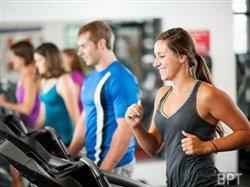Active resolutions: How to go from sore to more
Every year, about two-thirds of Americans resolve to get fit or lose weight. Unfortunately, 73 percent give up within six weeks, according to a survey by Harris Interactive. While time and commitment are often to blame, many fitness experts suggest sore and fatigued muscles have a lot to do with why we lose steam in a new routine.
"Muscles go through quite a bit of physical stress when we exercise," says Rick Sharp, professor of exercise physiology at Iowa State University in Ames and contributor to WebMD.com. "Mild soreness is just a natural outcome of any kind of physical activity. And they're most prevalent in beginning stages of a program."
Whether you’re sore from a new workout routine or everyday aches and pains, muscle management is a key to making physical exercise less of a chore. Here are three tips to reduce routine muscle pain, so you can go from sore to more.
Massage away
Massage is often thought of as relaxing, but new studies link massage to muscle treatment and recovery. In addition to relieving tension, massage may help reduce pain, decrease swelling and improve blood circulation. This promotes healing of soft-tissue damage, bruising and muscle fatigue. It also helps improve flexibility and mobility faster, while reducing overall stiffness.
New and powerful hand-held massagers, from manufacturers such as Wahl, make it possible to treat muscle pain and fatigue on a daily basis. Great information on therapeutic massage, its benefits, proper techniques and which type of massager is right for where it hurts can be found at wahlmassagers.com.
Stretch before and after
Most people associate stretching with improving flexibility. Stretching may actually help energy levels as well. Much like an engine needs to be primed before it fires up, stretching your muscles before working out gets the blood flowing throughout your body. This not only helps to reduce muscle-related injuries, but it reduces the buildup of lactic acid, which promotes fatigue. Once you’ve had a good stretch, ease your way into the workout to ensure your muscles are nice and loose before reaching “cruising speed.”
Heat up and cool down
Knowing when to apply hot and cold temperatures to sore muscles is critical to treating and healing them. Studies have shown alternating cold with hot to be highly effective in promoting both circulation and muscle recuperation. Temperature therapy also helps address specific muscle-related issues. Heat is often recommended for tight muscles, ligaments and tendons because it improves blood flow to the affected area. Cold therapy reduces swelling and helps control muscle spasms. New products such as the Hot-Cold Therapy Massager from Wahl combine massage and temperature therapy to provide a more comprehensive solution to muscle pain management.
Wahl is a leading manufacturer of massage therapy products available nationwide. For product information or to learn about the benefits of therapeutic massage, visit wahlmassagers.com.







